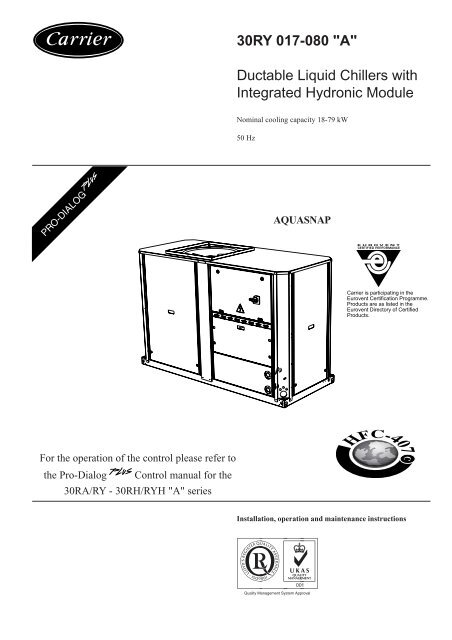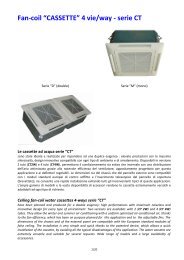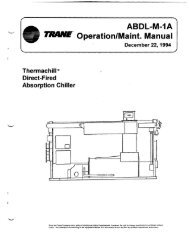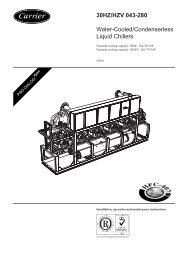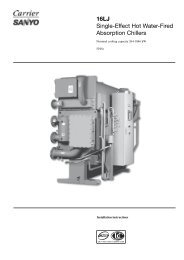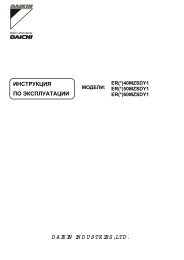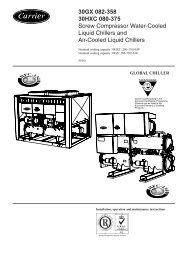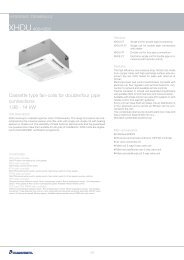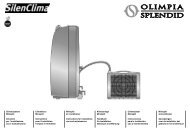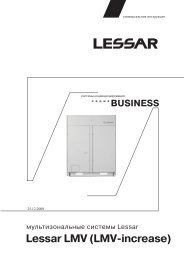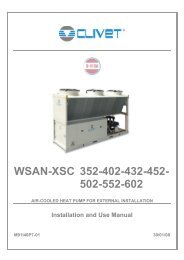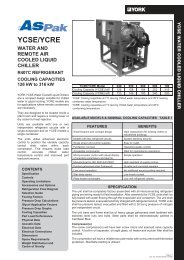"A" Ductable Liquid Chillers with Integrated Hydronic Module
"A" Ductable Liquid Chillers with Integrated Hydronic Module
"A" Ductable Liquid Chillers with Integrated Hydronic Module
Create successful ePaper yourself
Turn your PDF publications into a flip-book with our unique Google optimized e-Paper software.
30RY 017-080 "A"<strong>Ductable</strong> <strong>Liquid</strong> <strong>Chillers</strong> <strong>with</strong><strong>Integrated</strong> <strong>Hydronic</strong> <strong>Module</strong>Nominal cooling capacity 18-79 kW50 HzAQUASNAPCarrier is participating in theEurovent Certification Programme.Products are as listed in theEurovent Directory of CertifiedProducts.For the operation of the control please refer tothe Pro-Dialog Control manual for the30RA/RY - 30RH/RYH "A" seriesInstallation, operation and maintenance instructions
CONTENTS (cont’d)12 - MAINTENANCE ....................................................................................................................................................................2412.1 - General maintenance of the refrigerant circuit....................................................................................................................... 2412.2 - Verification of the refrigerant charge ..................................................................................................................................... 2412.3 - Apparent and actual subcooling ............................................................................................................................................. 2412.4 - Refrigerant guidelines ............................................................................................................................................................ 2512.5 - Recharging liquid refrigerant ................................................................................................................................................. 2512.6 - Undercharge ........................................................................................................................................................................... 2512.7 - Characteristics of R407C ....................................................................................................................................................... 2512.8 - Electrical maintenance ........................................................................................................................................................... 2512.9 - Condenser coil ........................................................................................................................................................................ 2613 - AQUASNAP MAINTENANCE PROGRAM ....................................................................................................................... 2713.1 - Maintenance schedule ............................................................................................................................................................ 2713.2 - Description of the maintenance operations ............................................................................................................................ 2714 - START-UP CHECKLIST FOR 30RY LIQUID CHILLERS ............................................................................................293
1 - INTRODUCTIONPrior to the initial start-up of the 30RY units, the peopleinvolved in the on-site installation, start-up, operation, andmaintenance of this unit should be thoroughly familiar <strong>with</strong>these instructions and the specific project data for theinstallation site.The 30RY liquid chillers are designed to provide a very highlevel of safety during installation, start-up, operation andmaintenance. They will provide safe and reliable service whenoperated <strong>with</strong>in their application range.This manual provides the necessary information to familiarizeyourself <strong>with</strong> the control system before performing start-upprocedures. The procedures in this manual are arranged in thesequence required for machine installation, start-up, operationand maintenance.Be sure you understand and follow the procedures and safetyprecautions contained in the instructions supplied <strong>with</strong> themachine, as well as those listed in this guide.Earthquake resistance has not been verified for standard units.1.1 - Installation safety considerationsThis machine must be installed in a location that is not accessibleto the public and protected against access by non-authorisedpeople.After the unit has been received, when it is ready to be installedor reinstalled, and before it is started up, it must be inspectedfor damage. Check that the refrigerant circuit(s) is (are) intact.Ensure especially that no components or pipes have shifted(e.g. following a shock). If in doubt, carry out a leak tightnesscheck and verify <strong>with</strong> the manufacturer that the circuit integrityhas not been impaired. If damage is detected upon receipt,immediately file a claim <strong>with</strong> the shipping company.Do not remove the skid or the packaging until the unit is in itsfinal position. These units can be moved <strong>with</strong> a fork lift truck,as long as the forks are positioned in the right place anddirection on the unit.The units can also be lifted <strong>with</strong> slings, using only the designatedlifting points marked at the four corners at the unit base.These units are not designed to be lifted from above. Useslings <strong>with</strong> the correct capacity, and always follow the liftinginstructions on the certified drawings supplied <strong>with</strong> the unit.Safety is only guaranteed, if these instructions are carefullyfollowed. If this is not the case, there is a risk of materialdeterioration and injuries to personnel.Never cover any safety devices.This applies to the globe valve in the water circuit and theglobe valve(s) in the refrigerant circuit(s).In certain cases the globe stops are installed on ball valves.These valves are factory-supplied lead-sealed in the openposition. This system permits isolating and removing theglobe stop for checking and replacing. The globe stops aredesigned and installed to ensure protection against fire risk.Removing the globe stops is only permitted if the fire risk isfully controlled and the responsibility of the user.All factory-installed globe valves are lead-sealed to preventany calibration change. If the globe valves are installed on areversing valve (change-over), this is equipped <strong>with</strong> a globevalve on each of the two outlets. Only one of the two glovevalves is in operation, the other one is isolated. Never leavethe reversing valve in the intermediate position, i.e. <strong>with</strong> bothways open (locate the control element in the stop position). Ifa globe stop is removed for checking or replacement pleaseensure that there is always an active globe stop on each of thereversing valves installed in the unit.Provide a drain in the discharge circuit, close to each valve,to avoid an accumulation of condensate or rain water.The safety valves must be connected to discharge pipes. Thesepipes must be installed in a way that ensures that people andproperty are not exposed to refrigerant leaks. These fluidsmay be diffused in the air, but far away from any building airintake, or they must be discharged in a quantity that isappropriate for a suitably absorbing environment.Periodic check of the globe valves: See paragraph“Maintenance safety considerations”.Accumulation of refrigerant in an enclosed space candisplace oxygen and cause asphyxiation or explosions.Inhalation of high concentrations of vapour is harmful andmay cause heart irregularities, unconsciousness, or death.Vapour is heavier than air and reduces the amount of oxygenavailable for breathing. These products cause eye and skinirritation. Decomposition products are hazardous.1.2 - Equipment and components under pressureThese products incorporate equipment or components underpressure, manufactured by Carrier or other manufacturers. Werecommend that you consult your appropriate national tradeassociation or the owner of the equipment or components underpressure (declaration, re-qualification, retesting, etc.). Thecharacteristics of this equipment/these components are givenon the nameplate or in the required documentation, supplied<strong>with</strong> the products.Do not introduce high static and dynamic pressure compared<strong>with</strong> the existing operating pressures - either service or testpressures in the refrigerant circuit or in the heat transfer circuit,especially:- limiting the elevation of the condensers or evaporators- taking the circulating pumps into consideration.Ensure that the valves (if used in the refrigerant circuit) arecorrectly installed, before operating the unit.4
1.3 - Maintenance safety considerationsEngineers working on the electric or refrigeration componentsmust be authorized and fully qualified to do so (electricianstrained and qualified in accordance <strong>with</strong> IEC 60364 ClassificationBA4).All refrigerant circuit repairs must be carried out by a trainedperson, fully qualified to work on these units. He must havebeen trained and be familiar <strong>with</strong> the equipment and theinstallation, and he must wear the necessary protective items(gloves, glasses, protective clothes, safety shoes).Soldering and welding: Component, piping and connectionsoldering and welding operations must be carried out using thecorrect procedures and by qualified operators. Pressurisedcontainers must not be subjected to shocks, nor to largetemperature variations during maintenance and repair operations.Never work on a unit that is still energized.Never work on any of the electrical components, until thegeneral power supply to the unit has been cut using thedisconnect switch in the control box.If any maintenance operations are carried out on the unit,lock the power supply circuit in the open position ahead ofthe machine.If the work is interrupted, always ensure that all circuits arestill deenergized before resuming the work.ATTENTION: Even if the unit has been switched off, thepower circuit remains energized, unless the unit or circuitdisconnect switch is open. Refer to the wiring diagram forfurther details. Attach appropriate safety labels.Operating checks: During the life-time of the system,inspection and tests must be carried out in accordance <strong>with</strong>national regulations.The information on operating inspections given in annex C ofstandard EN378-2 can be used if no similar criteria exist inthe national regulations.Safety device checks (annex C6 – EN378-2): The safetydevices must be checked on site once a year for safety devices(high-pressure switches), and every five years for externaloverpressure devices (safety globe valves).Contact Carrier Service for a detailed explanation of thehigh-pressure switch test method.If the machine operates in a corrosive environment, inspectthe protection devices more frequently.Regularly carry out leak tests and immediately repair any leaks.1.4 - Repair safety considerationsAll installation parts must be maintained by the personnel incharge, in order to avoid material deterioration and injuries topeople. Faults and leaks must be repaired immediately. Theauthorized technician must have the responsibility to repair thefault immediately. Each time repairs have been carried out tothe unit, the operation of the safety devices must be re-checked.If a leak occurs or if the refrigerant becomes polluted (e.g. by ashort circuit in a motor) remove the complete charge using arecovery unit and store the refrigerant in mobile containers(careful in case the refrigerant decomposes due to high temperatureincreases, as the decomposition products are dangerous).If a leak occurs, evacuate all refrigerant, repair the leak detectedand recharge the circuit <strong>with</strong> the total R407C charge, as indicatedon the unit name plate. Never top up the charge. Onlycharge liquid refrigerant R407C at the liquid line.Ensure that you are using the correct refrigerant type beforerecharging the unit.Charging any refrigerant other than the original charge type(R407C) will impair machine operation and can even lead toa destruction of the compressors. The compressors operating<strong>with</strong> this refrigerant type are charged <strong>with</strong> a synthetic polyolesteroil.These units have a hermetic refrigerant circuit and theoriginal charge need not be topped up.Do not use oxygen to purge lines or to pressurize a machinefor any purpose. Oxygen gas reacts violently <strong>with</strong> oil, grease,and other common substances.Never exceed the specified maximum operating pressures.Verify the allowable maximum high- and low-side test pressuresby checking the instructions in this manual and thepressures given on the unit name plate.Do not use air for leak testing. Use only refrigerant or drynitrogen.Do not unweld or flamecut the refrigerant lines or any refrigerantcircuit component until all refrigerant (liquid andvapour) has been removed from chiller. Traces of vapourshould be displaced <strong>with</strong> dry air nitrogen. Refrigerant incontact <strong>with</strong> an open flame produces toxic gases.The necessary protection equipment must be available, andappropriate fire extinguishers for the system and therefrigerant type used must be <strong>with</strong>in easy reach.Do not siphon refrigerant.Avoid spilling liquid refrigerant on skin or splashing it intothe eyes. Use safety goggles. Wash any spills from the skin<strong>with</strong> soap and water. If liquid refrigerant enters the eyes,immediately and abundantly flush the eyes <strong>with</strong> water andconsult a doctor.Never apply an open flame or live steam to a refrigerantcontainer. Dangerous overpressure can result. If it isnecessary to heat refrigerant, use only warm water.5
During refrigerant removal and storage operations followapplicable regulations. These regulations, permitting conditioningand recovery of halogenated hydrocarbons under optimumquality conditions for the products and optimum safetyconditions for people, property and the environment aredescribed in standard NFE 29795.Any refrigerant transfer and recovery operations must becarried out using a transfer unit. A 3/8” SAE connector onthe manual liquid line valve is supplied <strong>with</strong> all units forconnection to the transfer station. The units must never bemodified to add refrigerant and oil charging, removal andpurging devices. All these devices are provided <strong>with</strong> the units.Please refer to the certified dimensional drawings for the units.Do not drain water circuits containing industrial brines,<strong>with</strong>out informing the technical service department at theinstallation site or a competent body first.Close the entering and leaving water shutoff valves andpurge the unit hydronic circuit, before working on thecomponents installed on the circuit (screen filter, pump, waterflow switch, etc.).Periodically inspect all valves, fittings and pipes of therefrigerant and hydronic circuits to ensure that they do notshow any corrosion or any signs of leaks.Do not re-use disposable (non-returnable) cylinders orattempt to refill them. It is dangerous and illegal. Whencylinders are empty, evacuate the remaining gas pressure,and move the cylinders to a place designated for theirrecovery. Do not incinerate.Do not attempt to remove refrigerant circuit components orfittings, while the machine is under pressure or while it isrunning. Be sure pressure is at 0 kPa before removingcomponents or opening a circuit.Any manipulation (opening or closing) of a shut-off valvemust be carried out by a qualified and authorised engineer.These procedures must be carried out <strong>with</strong> the unit shut-down.NOTE: The unit must never be left shut down <strong>with</strong> the liquidline valve closed, as liquid refrigerant can be trapped betweenthis valve and the expansion device. (This valve is situated onthe liquid line before the filter drier box.)Do not attempt to repair or recondition any safety deviceswhen corrosion or build-up of foreign material (rust, dirt,scale, etc.) is found <strong>with</strong>in the valve body or mechanism. Ifnecessary, replace the device. Do not install safety valves inseries or backwards.CAUTION: Do not step on refrigerant lines. The lines canbreak under the weight and release refrigerant, causingpersonal injury.No part of the unit must use feet, racks or supports duringoperation. Periodically monitor and repair or if necessaryreplace any component or piping that shows signs of damage.Do not climb on a machine. Use a platform, or staging towork at higher levels.Use mechanical lifting equipment (crane, hoist, etc.) to lift ormove heavy components such as compressors or plate heatexchangers. For lighter components, use lifting equipmentwhen there is a risk of slipping or losing your balance.Use only original replacement parts for any repair or componentreplacement. Consult the list of replacement parts thatcorresponds to the specification of the original equipment.6
2 - PRELIMINARY CHECKS2.1 - Check equipment received• Inspect the unit for damage or missing parts. If damage isdetected, or if shipment is incomplete, immediately file aclaim <strong>with</strong> the shipping company.• Confirm that the unit received is the one ordered.Compare the name plate data <strong>with</strong> the order.• The unit name plate must include the followinginformation:- Version number- Model number- CE marking- Serial number- Year of manufacture and test date- Refrigerant used and refrigerant class- Refrigerant charge per circuit- Containment fluid to be used- PS: Min./max. allowable pressure (high and lowpressure side)- TS: Min./max. allowable temperature (high and lowpressure side)- Globe valve cut-out pressure- Pressure switch cut-out pressure- Unit leak test pressure- Voltage, frequency, number of phases- Maximum current drawn- Maximum power input- Unit net weightHigh pressure Low pressureMin. Max. Min. Max.PS (bar) -0.9 32 -0.9 25TS (°C) -20 72 -20 62Pressure switch cut-out pressure (bar) 29 -Valve cut-out pressure (bar) - 25Test pressure, unit leak test (bar) 15• Confirm that all accessories ordered for on-site installationhave been delivered, and are complete and undamaged.• The unit must be checked periodically during its wholeoperating life to ensure that no shocks (handlingaccessories, tools etc.) have damaged it. If necessary, thedamaged parts must be repaired or replaced. See alsochapter “Maintenance”.2.2 - Moving and siting the unit2.2.1 - MovingSee chapter "Installation safety considerations"2.2.2 - Siting the unitAlways refer to the chapter "Dimensions and clearances" toconfirm that there is adequate space for all connections andservice operations. For the centre of gravity coordinates, theposition of the unit mounting holes, and the weight distributionpoints, refer to the certified dimensional drawing supplied<strong>with</strong> the unit.CAUTION: Only use slings at the designated lifting pointswhich are marked on the unit.Before siting the unit check that:• the permitted loading at the site is adequate or thatappropriate strengthening measures have been taken;• the surface is horizontal, flat and intact;• a channel is provided all the way around the unit to collectthe condensate water.• if the unit is not equipped <strong>with</strong> the accessory condensaterecovery pan, reference is made to the installation conditionsin chapter 10.4;• there is adequate space above the unit for air flow;• there are adequate support points and that they are in theright places;• the location is not subject to flooding;• units <strong>with</strong> the outdoor installation option should not beinstalled where there is a risk of snow build-up. In areasthat are subject to long periods of sub-zero temperaturesraise the unit to a higher level.Baffles may be necessary to deflect strong winds and toprevent snow from blowing directly into the unit. Theymust not restrict air flow into the unit.CAUTION: Before lifting the unit, check that all casingpanels are securely fixed in place. Lift and set down the unit<strong>with</strong> great care. Tilting and jarring can damage the unit andimpair unit operation.The 30RY units can be hoisted <strong>with</strong> rigging. Coils shouldalways be protected against crushing while a unit is beingmoved. Use struts or spreader bars to spread the slings abovethe unit. Do not tilt a unit more than 15°.WARNING: Never push or lever on any of the enclosurepanels of the unit. Only the base of the unit frame is designedto <strong>with</strong>stand such stresses.7
Checks before system start-upBefore the start-up of the refrigeration system, the completeinstallation, including the refrigeration system must be verifiedagainst the installation drawings, dimensional drawings, systempiping and instrumentation diagrams and the wiring diagrams.During the installation test national regulations must befollowed. If no national regulation exists, paragraph 9-5 ofstandard EN 378-2 can be used as a guide.External visual installation checks:• Compare the complete installation <strong>with</strong> the refrigerationsystem and power circuit diagrams.• Check that all components comply <strong>with</strong> the designspecifications.• Check that all safety documents and equipments that arerequired by current European standards are present.• Verify that all safety and environmental protection devicesand arrangements are in place and comply <strong>with</strong> the currentEuropean standard.• Verify that all document for pressure containers,certificates, name plates, files, instruction manuals that arerequired documents required by the current Europeanstandards are present.• Verify the free passage of access and safety routes.• Check that ventilation in the plant room is adequate.• Check that refrigerant detectors are present.• Verify the instructions and directives to prevent thedeliberate removal of refrigerant gases that are harmful tothe environment.• Verify the installation of connections.• Verify the supports and fixing elements (materials, routingand connection).• Verify the quality of welds and other joints.• Check the protection against mechanical damage.• Check the protection against heat.• Check the protection of moving parts.• Verify the accessibility for maintenance or repair and tocheck the piping.• Verify the status of the valves.• Verify the quality of the thermal insulation and of thevapour barriers.8
10003 - DIMENSIONS/CLEARANCES30RY 017-033961.5922.5863205830RY 040-08011281068209720581350.71351670670110001000820Legend:All dimensions are given in mm8201Power supplyWater inlet1Water outletNOTE:Required clearances for air flowAir entering connectionAir leaving connectionPower cable entryABCNon-certified drawings.Refer to the certified dimensional drawings supplied <strong>with</strong> the unit oravailable on request, when designing an installation.For the location of fixing points, weight distribution and coordinates ofthe centre of gravity refer to the certified dimensional drawings.Install a condensate collection channel around the unit, or install theaccessory condensate recovery pan.The unit must be installed level in both axes (less than 2 mm toleranceper metre).9
4 - PHYSICAL DATA30RY 017 021 026 033 040 050 060 070 080Net nominal cooling capacity, single pump* kW 18.6 23.1 26 31.8 39.3 50 58 68 79Net nominal cooling capacity, dual pump* kW - - - - 38.1 49 57 67 79Operating weightkg<strong>with</strong> hydronic module, single pump 386 416 436 451 510 572 587 638 675<strong>with</strong> hydronic module, dual pump - - - - 590 652 667 718 752Operating weight <strong>with</strong>out hydronic module kg 361 391 411 426 486 548 563 614 649Refrigerant charge R-407C kg 6.6 6.3 7.45 7.85 9.75 11.1 11.8 13.3 17.0CompressorsHermetic, scroll 48.3 r/sQuantity 1 1 1 1 1 2 2 2 2Number of capacity steps 1 1 1 1 1 2 2 2 2Minimum capacity % 100 100 100 100 100 46 42 50 50Control typePRO-DIALOG PlusCondensersGrooved copper tubes and aluminium finsFanAxial fan <strong>with</strong> available static pressureQuantity 1 1 1 1 1 1 1 1 1Available static presure Pa 100 100 100 100 150 150 150 150 150Air flow (high speed) l/s 1940 1940 1940 2500 3890 3890 4720 5830 5830Speed (high/low) r/s 24/12 24/12 24/12 24/12 24/12 24/12 24/12 24/12 24/12EvaporatorWelded, direct-expansion plate heat exchangerWater volume l 1.6 2.0 2.3 3.0 3.6 4.6 5.9 6.5 7.6Max. water-side operating pressurekPa<strong>with</strong> hydronic module 250 250 250 250 300 300 300 300 300<strong>with</strong>out hydronic module 1000 1000 1000 1000 1000 1000 1000 1000 1000<strong>Hydronic</strong> modulePump, safety valve, expansion tank, flow switch and flow control valve.Screen filter, pressure gauges,Victaulic screen filter, pressure gauge,purge valvespurge valves (air and water)Pump, single, centrifugal Multicell pump, 48.3 r/s Composite monocell pump, 48.3 r/sQuantity 1 1 1 1 1 1 1 1 1Expansion tank volume l 8 8 8 8 12 12 12 12 12Water connection type Threaded male conical gas connection Victaulic (sleeves for welded or screw connection(<strong>with</strong> or <strong>with</strong>out hydronic module) supplied)Diameter in 1-1/4 1-1/4 1-1/4 1-1/4 2 2 2 2 2Outside tube diameter in 1-1/4 1-1/4 1-1/4 1-1/4 2 2 2 2 2mm 42.4 42.4 42.4 42.4 60.3 60.3 60.3 60.3 60.3* Net nominal cooling capacity based on Eurovent conditions = gross cooling capacity plus the capacity corresponding to the available pressure (flow x pressure/0.3)Standard EUROVENT conditions: evaporator entering/leaving water = 12°C/7°C, outdoor air temperature = 35°C5 - ELECTRICAL DATA30RY 017 021 026 033 040 050 060 070 080Power circuitNominal voltage V-ph-Hz 400-3-50Voltage range V 360-440Control circuit supplyThe control circuit is supplied via the transformer installed on the unitMaximum unit power input* kW 9.78 12.05 13.75 17.35 21 25.3 31.1 36.8 42.9Nominal unit current draw** A 15.1 17.8 19.91 26.3 30.9 36.5 46.8 56.2 62.5Maximum unit current draw*** A 17.2 21 23.7 29.9 35.9 43.5 53.9 63.4 72.4Maximum start-up currentAStandard unit† 89.8 133.8 133.8 139.4 181.4 153.6 163.4 172.9 217.9Unit <strong>with</strong> electronic starter (option)‡ - - - - 120.1 108.1 116.2 125.7 156.7Three-phase short-circuit holding current kA 10 10 10 10 10 10 10 10 10* Power input, compressor(s) + fan(s) + pump, at max. unit operating conditions (water entering/leaving temperature = 15°C/10°C and a maximum air enteringtemperature of 45°C ± 1 K depending on the unit size and at a nominal voltage of 400 V) - (values given on the unit name plate).** Nominal unit operating current draw at standard Eurovent conditions: evaporator entering/leaving water = 12°C/7°C, outdoor air temperature = 35°C. The currentvalues are given for a nominal voltage of 400 V (values given on the unit name plate).*** Maximum unit operating current at maximum unit power input and 400 V (data shown on the unit name plate).† Maximum instantaneous starting current at 400 V nominal voltage (maximum operating current of the smallest compressors + fan current + pump current + lockedrotor current of the largest compressor).‡ Maximum instantaneous starting current at 400 V nominal voltage and <strong>with</strong> compressor <strong>with</strong> electronic starter (maximum operating current of the smallestcompressor(s) + fan current + pump current + reduced start-up current of the largest compressor).10
Compressor usage and electrical dataCOMPRESSOR30RYReference code I Nom I Max LRA Circuit 017 021 026 033 040 050 060 070 080DQ 12 CA 025EE 11.3 17.0 86 A A1DQ 12 CA 001EE 14.0 19.1 130 A A1 A1DQ 12 CA 002EE 16.2 22.1 130 A A1 A2DQ 12 CA 003EE 14.8 20.3 120 A A1DQ 12 CA 005EE 21.9 28.3 135 A A1 A2 A1+A2DQ 12 CA 006EE 24.5 32.9 175 A A1 A1+A2Legend:I Nom Nominal current draw at Eurovent conditions (see definition of conditions under nominal unit current draw), AI Max Maximum operating current at 360 V, ALRA Locked rotor current, AElectrical data notes for 30RY units:• 30RY 017-080 units have a single power connection point.• The control box includes the following standard features:- Starter and motor protection devices for each compressor, fan, optionalpump- Control devices• Field connections:All connections to the system and the electrical installations must be in fullaccordance <strong>with</strong> all applicable codes.• The Carrier 30RY 017-080 units are designed and built to ensure conformance<strong>with</strong> local codes. The recommendations of European standard EN 60204-1(machine safety - electrical machine components - part 1: general regulations -corresponds to IEC 60204-1) are specifically taken into account whendesigning the electrical equipment.IMPORTANT:• Generally the recommendations of IEC 60364 are accepted as compliance<strong>with</strong> the requirements of the installation directives. Conformance <strong>with</strong> EN60204-1 is the best means of ensuring compliance <strong>with</strong> the Machines Directive§ 1.5.1.• Annex B of EN 60204-1 describes the electrical characteristics used for theoperation of the machines.1. The operating environment for the 30RY units is specified below:a. 30RY 017-080 – Indoor installationEnvironment* - Environment as classified in IEC 60364 § 3:- ambient temperature range: +5°C to +40°C, class AA4- humidity range (non-condensing)*:50% relative humidity at 40°C90% relative humidity at 20°C- altitude: ≤ 2000 m- indoor installation*- presence of water, class AD2* (possibility of water droplets)- presence of hard solids, class AE2* (no significant dust present)- presence of corrosive and polluting substances, class AF1 (negligible)- vibration and shock, class AG2, AH2Competence of personnel, class BA4* (trained personnel - IEC 60364)b. 30RY 040-080 – outdoor installationEnvironment** - Environment as classified in EN 60721 (corresponds to IEC60721):- outdoor installation**- ambient temperature range: -10°C to +46°C, class 4K3**- altitude: ≤ 2000 m- presence of hard solids: class 4S2** (no significant dust present)- presence of corrosive and polluting substances, class 4C2 (negligible)- vibration and shock, class 4M2Competence of personnel, class BA4** (trained personnel - IEC 60364)2. Power supply frequency variation: ± 2 Hz.3. The neutral (N) conductor must not be connected directly to the unit (ifnecessary use a transformer).4. Overcurrent protection of the power supply conductors is not provided <strong>with</strong> theunit.5. The factory-installed disconnect switch(es)/circuit breaker(s) is (are) of a typesuitable for power interruption in accordance <strong>with</strong> EN 60947.6. The units are designed for connection to TN networks (IEC 60364). For ITnetworks the earth connection must not be at the network earth. Provide alocal earth, consult competent local organisations to complete the electricalinstallation.NOTE: If particular aspects of an actual installation do not conform to theconditions described above, or if there are other conditions which should beconsidered, always contact your local Carrier representative.* The protection level required to conform to this class is IP21B (according toreference document IEC 60529). All 30RY 017-080 units are protected toIP23C and fulfil this protection condition.** The required protection level for this class is IP43BW (according to referencedocument IEC 60529). All 30RY 040-080 units are protected to IP45CW andfulfil this protection condition.11
6 - APPLICATION DATA6.1 - Unit operating rangeEvaporator Minimum °C Maximum °CWater entering temp. (at start-up) 7.8 * 30Water leaving temp. (in operation) 5 ** 10Water entering temp. (at shut down) - 50CondenserEntering air temp. -10*** 46***This volume is required to obtain temperature stability andprecision.To achieve this volume, it may be necessary to add a storagetank to the circuit. This tank should be equipped <strong>with</strong> baffles toallow mixing of the fluid (water or brine). Please refer to theexamples below.Do not exceed the maximum operating temperature.* For a system requiring operation below 7,8°C, contact Carrier SA.** For a system requiring operation below 5°C, anti-freeze must be added to theunit.*** Maximum outside temperature: For transport and storage of the 30RY unitsthe minimum and maximum allowable temperatures are –20°C and +55°C. Itis recommended that these temperatures are used for transport by container.BadGood6.2 - Evaporator water flow rates30RY Evaporator water flowMin. flow rate Max. flow rate* Max. flow rate**Single pump Dual pumpl/s l/s l/s l/s017 0.58 1.7 0 1.7021 0.70 1.8 0 1.9026 0.81 1.9 0 2.2033 1.10 2.0 0 3.0040 1.20 3.5 4.4 3.7050 1.19 4.0 5.2 4.6060 1.46 4.4 6.0 5.8070 1.66 4.6 6.4 6.4080 1.92 5.5 6.8 7.3* Maximum flow rate at an available pressure of 50 kPa (unit <strong>with</strong> hydronicmodule).** Maximum flow rate at a pressure drop of 100 kPa in the plate heat exchanger(unit <strong>with</strong>out hydronic module).6.3 - Minimum water flow rateIf the installation flow rate is below the minimum flow rate,recirculation of the evaporator water flow may take place,leading to the risk of excessive fouling.6.4 - Maximum evaporator water flow rateThis is limited by the permitted evaporator pressure drop.Also, a minimum evaporator ∆T of 2.8 K must be guaranteed,which corresponds to a water flow rate of 0.9 l/s per kW.6.5 - Water loop volume6.5.1 - Minimum water loop volumeThe minimum water loop volume, in litres, is given by thefollowing formula:Volume = CAP (kW) x N* = litres, where CAP is the nominalcooling capacity at nominal operating conditions.Application N*Air conditioning30RY 017-040 3.530RY 050-240 2.5Industrial process cooling30RY 017-080(See note)NOTE: For industrial process cooling applications, wherehigh stability of the water temperature levels must beachieved, the values above must be increased.6.5.2 - Maximum water loop volumeUnits <strong>with</strong> hydronic module incorporate an expansion tank thatlimits the water loop volume. The table below gives themaximum loop volume for pure water or ethylene glycol <strong>with</strong>various concentrations.30RY 017-033 30RY 040-080(in litres)(in litres)Pure water 400 600Ethylene glycol 10% 300 450Ethylene glycol 20% 250 400Ethylene glycol 35% 200 300Entering air temperatureEG: Ethylene glycol6.6 - 30RY unit operating range at full and part load˚C464544.5440-10BadGood0 1 2 3 4 5 6 7 8 9 10 ˚CEvaporator water leaving temperatureNotes1 Evaporator ∆T = 5 K2 The evaporator and the hydronic circuit pump are frost protected downto -20°C.Operating range <strong>with</strong> required anti-freeze solution and special Pro-Dialogcontrol configuration12
6.7 - Pressure drop in the plate heat exchangers200010002134Pressure drop, kPa100567891011 10Water flow rate, l/sLegend1 30RY 0172 30RY 0213 30RY 0264 30RY 0335 30RY 0406 30RY 0507 30RY 0608 30RY 0709 30RY 08013
7 - ELECTRICAL CONNECTION30RY 017-033Control boxNOTES: The 30RY units have only one power connectionpoint located at the main disconnect switch.Before connecting electric power cables, it is imperative tocheck the correct order of the 3 phases (L1 - L2 - L3).ANon-certified drawings. Refer to the certified drawingssupplied <strong>with</strong> the unit or available on request.7.1 - Power supplyThe power supply must conform to the specification on thechiller name plate. The supply voltage must be <strong>with</strong>in the rangespecified in the electrical data table.For connections refer to the wiring diagrams.33338PEWARNING: Operation of the chiller <strong>with</strong> an improper supplyvoltage or excessive phase imbalance constitutes abuse whichwill invalidate the Carrier warranty. If the phase imbalanceexceeds 2% for voltage, or 10% for current, contact your localelectricity supply source at once and ensure that the chiller isnot switched on until corrective measures have been taken.30RY 040-080Control boxSL1 L2 L3A1397.2 - Voltage phase imbalance (%)100 x max. deviation from average voltageAverage voltageExample:On a 400 V - 3 ph - 50 Hz supply, the individual phase voltageswere measured to be:AB = 406 V ; BC = 399 ; AC = 394 VAverage voltage = (406 + 399 + 394)/3 = 1199/3= 399.7 say 400 VBCalculate the maximum deviation from the 400 V average:(AB) = 406 - 400 = 6(BC) = 400 - 399 = 1(CA) = 400 - 394 = 6PE813333MotorThe maximum deviation from the average is 6 V. The greatestpercentage deviation is:100 x 6/400 = 1.5 %143SL1 L2 L3This is less than the permissible 2% and is therefore acceptable.BLegend1 Main disconnect switchPE Earth connectionS Power supply cable section (see table "Recommended wire sections").For copper cables use electrolytic copper (AMP type) cable stiffeners <strong>with</strong>6 mm terminal for sizes 017 to 080.14
8 - RECOMMENDED WIRE SECTIONSWire sizing is the responsibility of the installer, and depends onthe characteristics and regulations applicable to each installationsite. The following is only to be used as a guideline, and doesnot make Carrier in any way liable. After wire sizing has beencompleted, using the certified dimensional drawing, the installermust ensure easy connection and define any modificationsnecessary on site. The connections provided as standard for thefield-supplied power entry cables to the general disconnect/isolator switch are designed for the number and type of wires,listed in the table below.8.1 - Field control wiringFor the field control wiring of the following elements pleaserefer to the 30RA/RY - RH/RYH “A” series Pro-Dialog PlusControl manual, and the certified wiring diagram supplied <strong>with</strong>the unit:- Unit start/stop- Heating/cooling selection- Set-point selection- Customer interlock - (example: auxiliary contact of thechilled water pump contactor)- General alarm reporting, circuit A and circuit BThe calculations are based on the maximum machine current(see electrical data tables) and the standard installation practises,in accordance <strong>with</strong> IEC 60364, table 52C.- For 30RY units, installed outside, the following standardinstallation practises have been maintained:No.17: suspended aerial lines, and No. 61: buriedconduit <strong>with</strong> a derating coefficient of 20.The calculation is based on PVC or XLPE insulatedcables <strong>with</strong> copper core.A maximum ambient temperature of 46°C has beentaken into consideration.The given wire length limits the voltage drop to< 5% (length L in metres - see table below).IMPORTANT: Before connection of the main power cables(L1 - L2 - L3) on the terminal block, it is imperative to checkthe correct order of the 3 phases before proceeding to theconnection on the main disconnect/isolator switch.Units S Min. (mm 2 ) Cable type L (m) S Max. (mm 2 ) Cable type L (m)by phaseby phase30RY 017 1x 6 XLPE Cu 90 1x 16 PVC Cu 24530RY 021 1x 6 XLPE Cu 90 1x 16 PVC Cu 24530RY 026 1x 6 XLPE Cu 90 1x 16 PVC Cu 24530RY 033 1x 6 XLPE Cu 90 1x 16 PVC Cu 24530RY 040 1x 6 XLPE Cu 90 1x 16 PVC Cu 24530RY 050 1x 6 XLPE Cu 80 1x 25 PVC Cu 30030RY 060 1x 10 XLPE Cu 110 1x 25 PVC Cu 30030RY 070 1x 10 XLPE Cu 100 1x 35 PVC Cu 31030RY 080 1x 16 XLPE Cu 125 1x 50 PVC Cu 350S Power supply cable section (see the diagram in chapter: "Electrical connection")15
9 - WATER CONNECTIONSFor size and position of the unit water inlet and outlet connectionsrefer to the certified dimensional drawings supplied <strong>with</strong>the unit. The water pipes must not transmit any radial or axialforce to the heat exchangers nor any vibration.The water supply must be analysed and appropriate filtering,treatment, control devices, shutoff and bleed valves and circuitsbuilt in, to prevent corrosion (example: damage to the protectionof the tube surface if the fluid is polluted), fouling and deteriorationof the pump fittings.Before any start-up verify that the heat exchange fluid iscompatible <strong>with</strong> the materials and the water circuit coating.In case additives or other fluids than those recommended byCarrier s.a are used, ensure that the fluids are not considered asa gas, and that they belong to class 2, as defined in directive97/23/EC.Carrier s.a. recommendations on heat exchange fluids:1. No NH 4+ ammonium ions in the water, they are verydetrimental for copper. This is one of the most importantfactors for the operating life of copper piping. A contentof several tenths of mg/l will badly corrode the copperover time.2. Cl - Chloride ions are detrimental for copper <strong>with</strong> a risk ofperforations by corrosion by puncture. If possible keepbelow 10 mg/l.3. SO 42-sulphate ions can cause perforating corrosion, iftheir content is above 30 mg/l.4. No fluoride ions (2.8 K. Values between 10 and 25can be recommended. This will facilitate scale deposit thatcan limit corrosion of copper. TH values that are too highcan cause piping blockage over time. A total alkalimetrictitre (TAC) below 100 is desirable.8. Dissolved oxygen: Any sudden change in water oxygenationconditions must be avoided. It is as detrimental todeoxygenate the water by mixing it <strong>with</strong> inert gas as it isto over-oxygenate it by mixing it <strong>with</strong> pure oxygen. Thedisturbance of the oxygenation conditions encouragesdestabilisation of copper hydroxides and enlargement ofparticles.9. Specific resistance – electric conductivity: the higher thespecific resistance, the slower the corrosion tendency.Values above 3000 Ohm/cm are desirable. A neutralenvironment favours maximum specific resistance values.For electric conductivity values in the order of 200-6000S/cm can be recommended.10. pH: Ideal case pH neutral at 20-25°C (7 < pH < 8).ATTENTION: Charging, adding or draining fluid from thewater circuit must be done by qualified personnel, using airvents and materials suitable for the products. The watercircuit charging devices are field-supplied.Charging and removing heat exchange fluids should be done<strong>with</strong> devices that must be included on the water circuit by theinstaller. Never use the unit heat exchangers to add heatexchange fluid.9.1 - Operating precautions and recommendationsThe water circuit should be designed to have the least numberof elbows and horizontal pipe runs at different levels. Belowthe main points to be checked for the connection:• Comply <strong>with</strong> the water inlet and outlet connections shownon the unit.• Install manual or automatic air purge valves at all highpoints in the circuit.• Use an expansion device to maintain pressure in thesystem and install a safety valve as well as an expansiontank.Units <strong>with</strong> a hydronic module include the safety valve andthe expansion tank.• Install thermometers in both the entering and leavingwater connections.• Install drain connections at all low points to allow thewhole circuit to be drained.• Install stop valves, close to the entering and leaving waterconnections.• Use flexible connections to reduce the transmission ofvibrations.• Insulate all pipework, after testing for leaks, both toreduce thermal leaks and to prevent condensation.• If the external unit water pipes are in an area, where theambient temperature is likely to fall below 0°C, insulate thepiping and add an electric heater. The internal unit pipingis protected down to -20°C.NOTE: For units not equipped <strong>with</strong> a hydronic module ascreen filter must be installed as close to the heat exchangeras possible, in a position that is easily accessible for removaland cleaning. Units <strong>with</strong> hydronic module are equipped <strong>with</strong>this type of filter.The mesh size of the filter must be 1.2 mm.The plate heat exchanger can foul up quickly at the initialunit start-up, as it complements the filter function, and theunit operation will be impaired (reduced water flow rate dueto increased pressure drop).Before the system start-up verify that the water circuits areconnected to the appropriate heat exchangers (e.g. noreversal between evaporator and condenser).Do not introduce any significant static or dynamic pressureinto the heat exchange circuit (<strong>with</strong> regard to the designoperating pressures).The products that may be added for thermal insulation of thecontainers during the water piping connection proceduremust be chemically neutral in relation to the materials andcoatings to which they are applied. This is also the case forthe products originally supplied by Carrier s.a.16
9.2 - <strong>Hydronic</strong> connectionsThe diagram on the next page shows a typical hydronicinstallation.When charging the water circuit use air vents to evacuate anyresidual air pockets.9.3 - Frost protectionThe plate heat exchangers, the piping and the hydronic modulepump can be damaged by frost, despite the built-in anti-freezeprotection of these units.The frost protection of plate heat exchanger and all hydronicmodule components is guaranteed down to -20°C (sizes 040-080 only) by automatically energized heaters and pump cycling.- To prevent corrosion by differential aeration, the completedrained heat transfer circuit must be charged <strong>with</strong>nitrogen for a period of one month. If the heat transferfluid does not comply <strong>with</strong> the Carrier S.A. regulations,the nitrogen charge must be added immediately.9.4 - Installation of the accessory condensaterecovery panRef. No.: 30RY 900 022 EE -- 30RY 017-03330RY 900 032 EE -- 30RY 040-080In heat pump mode it may be necessary to remove the water.Carrier can supply an accessory condensate recovery pan to bepositioned under the unit. This pan is connected to the condensaterecovery systems via a threaded 1" diameter gas pipe.Never switch off the evaporator and hydronic circuit heaters orthe pump, otherwise frost protection cannot be guaranteed.For this reason the main unit disconnect switch (QS101) aswell as the auxiliary protection switch (QF101) for the heatersmust always be left closed (for location of QS and QF 101 seewiring diagram).To ensure frost protection down to -20°C, water circulation inthe water circuit must be maintained by periodically switchingon the pump. If a shut-off valve is installed, a bypass must beincluded as shown below.Winter positionF1AOFBLegendA UnitB Water networkC ClosedO Open2IMPORTANT:Depending on the atmospheric conditions in your area youmust do the following when switching the unit off in winter:- Add ethylene glycol <strong>with</strong> an adequate concentration toprotect the installation up to a temperature of 10 K belowthe lowest temperature likely to occur at the installationsite.- If the unit is not used for an extended period, it isrecommended to drain it, and as a safety precautionintroduce ethylene glycol in the heat exchanger, usingthe water entering purge valve connection.At the start of the next season, refill the unit <strong>with</strong> waterand add an inhibitor.- For the installation of auxiliary equipment, the installermust comply <strong>with</strong> basic regulations, especially forminimum and maximum flow rates, which must bebetween the values listed in the operating limit table(application data).Legend1 Condensate recovery pan2 Connection17
Typical hydronic circuit diagram (30RY 040-080)1214171512410133185611131417159875Legend1916Components of the unit and hydronic module1 Victaulic screen filter2 Expansion tank3 Safety valve4 Available pressure pump5 Purge valve and pressure tap6 Pressure gauge to measure the plate heat exchanger pressure drop (to beisolated <strong>with</strong> valve No. 5 if not used)7 System air vent8 Flow switch9 Flow control valve10 Plate heat exchanger11 Evaporator defrost heaterInstallation components12 Air vent13 Thermometer sleeve14 Flexible connection15 Check valve16 System water drain plug (on connection pipe supplied in the unit)17 Pressure gauge18 Freeze-up protection bypass valve (when valve No. 15 are closed duringwinter)19 Charge valve--- <strong>Hydronic</strong> module (unit <strong>with</strong> hydronic module)Note:Units <strong>with</strong>out hydronic module are equipped <strong>with</strong> a flow switch and an internalpiping heater.18
10 - NOMINAL SYSTEM WATER FLOW CONTROLThe water circulation pumps of the 30RY units have been sizedto allow the hydronic modules to cover all possible configurationsbased on the specific installation conditions, i.e. for varioustemperature differences between the entering and the leavingwater (∆T) at full load, which can vary between 3 and 10 K.This required difference between the entering and leavingwater temperature determines the nominal system flow rate. Itis above all absolutely necessary to know the nominal systemflow rate to allow its control via a manual valve provided in thewater leaving piping of the module (item 9 in the typicalhydronic circuit diagram).With the pressure loss generated by the control valve in thehydronic system, the valve is able to impose the system pressure/flow curve on the pump pressure/flow curve, to obtain thedesired operating point (see example for 30RY 080). The pressuredrop reading in the plate heat exchanger is used to controland adjust the nominal system flow rate. The pressure drop ismeasured <strong>with</strong> the pressure gauge connected to the heatexchanger water inlet and outlet.Use this specification for the unit selection to know the systemoperating conditions and to deduce the nominal air flow as wellas the plate heat exchanger pressure drop at the specified conditions.If this information is not available at the system startup,contact the technical service department responsible for theinstallation to get it.These characteristics can be obtained from the technical literatureusing the unit performance tables for a ∆T of 5 K at theevaporator or <strong>with</strong> the Electronic Catalogue selection programfor all ∆T conditions other than 5 K in the range of 3 to 10 K.10.1 - Water flow control procedureAs the total system pressure drop is not known exactly at thestart-up, the water flow rate must be adjusted <strong>with</strong> the controlvalve provided to obtain the specific flow rate for this application.Proceed as follows:Open the valve fully (approximately 9 turns counter-clockwise).Start-up the pump using the forced start command (refer to thecontrols manual) and let the pump run for two consecutivehours to clean the hydronic circuit of the system (presence ofsolid contaminants).Read the plate heat exchanger pressure drop by taking thedifference of the readings of the pressure gauge connected tothe plate heat exchanger inlet and outlet, using valves (seediagrams below), and comparing this value after two hours ofoperation.LegendO OpenF ClosedWater inletWater outletEntering water pressure readingPressure gaugeNOTE: Applies to units 040 to 080FOFOLeaving water pressure readingFAir ventOIf the pressure drop has increased, this indicates that the screenfilter must be removed and cleaned, as the hydronic circuitcontains solid particles. In this case close the shutoff valves atthe water inlet and outlet and remove the screen filter afteremptying the hydronic section of the unit.Renew, if necessary, to ensure that the filter is not contaminated.Purge the air from the circuit (see 'Air vent' diagram).FFO19
When the circuit is cleaned, read the pressures at thepressure gauge (entering water pressure - leaving waterpressure), expressed in bar and convert this value to kPa(multiply by 100) to find out the plate heat exchangerpressure drop.Compare the value obtained <strong>with</strong> the theoretical selection value.If the pressure drop measured is higher than the value specifiedthis means that the flow rate in the plate heat exchanger (andthus in the system) is too high. The pump supplies an excessiveflow rate based on the global pressure drop of the application.In this case close the control valve one turn and read the newpressure difference.Proceed by successively closing the control valve until youobtain the specific pressure drop that corresponds to the nominalflow rate at the required unit operating point.- If the system has an excessive pressure drop in relation tothe available static pressure provided by the pump, theresulting water flow rate will de reduced and thedifference between entering and leaving watertemperature of the hydronic module will be increased.To reduce the pressure drops of the hydronic system, it isnecessary:- to reduce the individual pressure drops as much aspossible (bends, level changes, accessories, etc.)- to use a correctly sized piping diameter.- to avoid hydronic system extensions, wherever possible.10.2 - Pump curve and water flow control as afunction of the system pressure dropsPressure drop, kPaExample: 30RY 080 at Eurovent conditions of 3.8 l/s2001801601401201008060431210.3 - Pump pressure/flow rate curvesSingle pumpPressure supplied, kPa30027525022520017515012510075132500 1 2 3 4 5 6 7 8Legend1 30RY 017-0332 30RY 040-0703 30RY 080Dual pumpPressure supplied, kPa250225200175150125100751Water flow rate, l/s500 1 2 3 4 5 6 7 8Legend1 30RY 040-080Water flow rate, l/s402002 3 4 5 6 7 8LegendWater flow rate, l/s1 Pump curve, 30RY 0802 Plate heat exchanger pressure drop (to be measured <strong>with</strong> the pressure gaugeinstalled at the water inlet and outlet)3 Installation pressure drop <strong>with</strong> control valve wide open4 Installation pressure drop after valve control to obtain nominal flow rate20
10.4 - Available static system pressureSingle pump3002752502252001751501253100754501 25 6 7 8 9250 2 4 6Water flow rate, l/sLegend1 30RY 0172 30RY 0213 30RY 0264 30RY 0335 30RY 0406 30RY 0507 30RY 0608 30RY 0709 30RY 080Available static pressure, kPa10.5 - Duct connectionThe 30RY 017-080 can be installed inside a building andconnected to an air ductwork system:- air heat exchanger side, i.e. at the fresh air inlet side- fan discharge side, i.e. where the air treated by the heatexchanger is discharged.Installation in a room is thus possible <strong>with</strong>out disturbing theroom temperature.10.5.1 - Air return <strong>with</strong>out accessory filterThe units are supplied <strong>with</strong> a collar that permits connection ofa return air duct.Provide a removable window on the return air duct to permitmaintenance of the air temperature sensor.Air temperaturesensor positionDual pump225200Available static pressure, kPa17515012510075Legend1 30RY 0402 30RY 0503 30RY 0604 30RY 0705 30RY 080501 2 3 4 5250 2 4 6 8Water flow rate, l/s10.5.2 - Air return <strong>with</strong> accessory filterThe suction side connection collar must first be removed.Installation of the accessory on the unit can be done as follows:Accessory filters21
Accessory reference number:30RY-017-033: 30RY-900—002—EE—30RY-040-080: 30RY-900—012—EE—Replacement filter reference number:—KH—12AE-005—EE—30RY-017-033: quantity: 430RY-040-080: quantity: 6The connection of the return air duct is now very easy, directlyon the air filter accessory.Filter access for maintenance is ensured by removing the twoMetric screws on the unit side (rear view of the unit).The cover panel, supplied <strong>with</strong> a handle, can now be removed.The filters are attached to each other <strong>with</strong> a bracket that permitssliding them into the frames.10.5.3 - Fan dischargeA square flange is supplied mounted on the unit. An availablestandard round flange can easily be installed at the fan discharge,if the installer prefers the use of a round connection duct.The unit is supplied <strong>with</strong> a cover panel on the dischargeside. This panel has to be removed before connection to theduct system.30RY-017-033: standard 560 mm diameter fan30RY-040-080: standard 710 mm diameter fanFan data30RY Minimum available Nominal available Maximum availablestatic pressure* static pressure static pressurePressure Flow Pressure Flow Pressure FlowPa l/s Pa l/s Pa l/s017-026 0 2500 100 1940 150 1530033 0 2920 100 2500 200 1940040-050 0 4580 150 3890 230 3330060 0 5560 150 4720 230 4030070-080 0 6810 150 5830 230 5280* Operation <strong>with</strong>out duct systemMaximum air entering temperature, °C30RY At minimum At nominal At maximumair flow air flow air flow017-026 44 46 47.5033 44 46 47040-050 44.5 46 47060 44.5 46 47070-080 44.5 46 47Performance correction factors30RY Cooling capacity Power inputMin. flow Max. flow* Min. flow Max. flow*017-026 0.98 1.01 1.03 0.97033 0.98 1.005 1.03 0.98040-050 0.985 1.005 1.02 0.98060 0.985 1.005 1.02 0.98070-080 0.985 1.005 1.01 0.98* Operation <strong>with</strong>out duct systemCorrection factor for the published performances, given at nominal air flowIt is advisable to make the connection to the duct system <strong>with</strong> aflexible collar. If this recommendation is not observed, a lot ofvibration and noise may be transmitted to the building structure.14Accessory suction filter pressure dropThe unit construction does not permit the support of a ductweighing more than 10 kg. Non-observance may lead todamage of the unit.10.5.4 - Applicable regulations for units used <strong>with</strong> an airduct systemEnsure that the return or supply air openings cannot accidentallybe obstructed by panels (for example low return air or openingof doors).Unit performances are given for an air-side pressure drop thatis indicated in the Physical Data table.Additional pressure drop, Pa121086420017/026 033 040/050 060 070/080Unit sizeThe three tables that follow contain fan characteristics, maximumair entering temperatures and performance correctionfactors, depending on the air system used <strong>with</strong> the units.22
11 - START-UP11.1 - Preliminary checks- Never be tempted to start the chiller <strong>with</strong>out reading fully,and understanding, the operating instructions and <strong>with</strong>outhaving carried out the following pre-start checks:- Check the chilled water circulation pumps, air handlingunits and all other equipment connected to the evaporator.- Refer to the manufacturer's instructions.- For units <strong>with</strong>out hydronic module, the water pumpoverheat protection device must be connected in series<strong>with</strong> the pump contactor power supply. If the pump is notsupplied <strong>with</strong> the unit (unit <strong>with</strong>out hydronic module),verify that the power input of the field-installed pumpdoes not exceed the rating of the standard pump contactor,supplied in the control box (max. 3 kW).- Refer to the wiring diagram supplied <strong>with</strong> the unit.- Ensure that there are no refrigerant leaks.- Confirm that all pipe securing bands are tight.- Confirm the the electrical connections are secure.Depending on the installation and control type, each unit cancontrol its own water pump. If there is only one common pumpfor the two units, the master unit can control this. In this caseshut-off valves must be installed on each unit. They will beactivated at the opening and closing by the control of each unit(and the valves will be controlled using the dedicated waterpump outputs).30RY 017 to 080 (standard configuration: return watercontrol)1211.2 - Actual start-upIMPORTANT• Commissioning and start-up of the chiller must besupervised by a qualified refrigeration engineer.• It is strictly forbidden to energise the units, if the fan hasnot been connected to a duct system.30RY 017 to 080 (<strong>with</strong> configuration: leaving watercontrol)The outdoor installation option includes a protectiongrille that does not require this connection.• Start-up and operating tests must be carried out <strong>with</strong> athermal load applied and water circulating in theevaporator.• All set-point adjustments and control tests must becarried out before the unit is started up.• Please refer to the controls section of this manual.1 2The unit should be started up in Local ON mode.Ensure that all safety devices are satisfied, especially the highpressure switches.11.3 - Operation of two units in master/slave modeThe control of a master/slave assembly is in the entering waterand does not require any additional sensors (standard configuration).All parameters, required for the master/slave function must beconfigured using the Service Configuration menu. All remotecontrols of the master/slave assembly (start/stop, set point, loadshedding etc.) are controlled by the unit configured as masterand must only be applied to the master unit.IMPORTANT: The two units must be equipped <strong>with</strong> optionNo. 155 - CCN time scheduling and communications “ClockBoard”.Legend1 Master unit2 Slave unitAdditional CCN board (one per unit, <strong>with</strong> connection via communicationbus)Control boxes of the master and slave unitsWater inletWater outletWater pumps for each unit (included as standard for units <strong>with</strong> hydronicmodule)Additional sensors for leaving water control, to be connected to channel 1of the slave boards of each master and slave unitCCN communication busConnection of two additional sensors23
Pressure12 - MAINTENANCEAny technician attending the machine for any purpose must befully qualified to work on refrigerant and electrical circuits.All refrigerant charging, removal and draining operationsmust be carried out by a qualified technician and <strong>with</strong> thecorrect material for the unit. Any inappropriate handling canlead to uncontrolled fluid or pressure leaks.WARNING: Before doing any work on the machine ensurethat the power is switched off. If a refrigerant circuit is opened,it must be evacuated, recharged and tested for leaks. Beforeany operation on a refrigerant circuit, it is necessary toremove the complete refrigerant charge from the unit <strong>with</strong> arefrigerant charge recovery group.12.1 - General maintenance of the refrigerant circuitWARNING: To ensure proper operation of 30RY units theremust be at least 12 K of subcooling as the liquid refrigerantenters the expansion valve.The 30RY units use refrigerant. For your information, we arereproducing here some extracts from the official publicationdealing <strong>with</strong> the design, installation, operation andmaintenance of air conditioning and refrigeration systemsand the training of people involved in these activities, agreedby the air conditioning and refrigeration industry.12.3 - Apparent and actual subcooling32541• Keep the unit itself and the space around it clean and freeof obstructions. Remove all rubbish such as packingmaterials, as soon as the installation is completed.• Regularly clean the exposed pipework to remove all dustand dirt. This makes detection of water leaks easier, andthey can be repaired before more serious faults develop.• Confirm that all screwed and bolted connections andjoints are secure. Secure connections prevent leaks andvibration from developing.• Check that all insulation joints are securely closed andthat all insulation is firmly in place. Check all heatexchangers and all pipework.If water jets are used inside the units (e.g. to clean the coils), thelower holes (for possible condensate removal) must be blocked.12.2 - Verification of the refrigerant chargeCAUTION: The 30RY units are supplied <strong>with</strong> a preciserefrigerant charge (see Physical Data table).To verify the correct system charge prodeed as follows:Ensure that no bubbles appear in the sight-glass, when operatingthe unit at full load for a while, at a saturated condensingtemperature of between 55 and 57°C. If necessary cover asection of the coil surface to obtain this condensing temperature.Under these conditions the apparent subcooling which isequal to the saturated condensing temperature (1 - on thesaturated dew point curve) minus the liquid refrigerant temperature(3) ahead of the expansion device must be between 12and 14°C. This corresponds to an actual subcooling temperatureof between 5 and 7 K at the condenser outlet, depending on theunit type. Actual subcooling is equal the saturated liquid temperature(2 - on the saturated bubble point curve) minus theliquid refrigerant temperature (3) ahead of the expansion device.Use the pressure tap supplied on the liquid piping to chargerefrigerant and to find out the pressure of the liquid refrigerant.If the subcooling value is not correct, i.e. lower than the specifiedvalues, a leak detection test must be carried out on the unit,as it no longer contains its original charge.In order to measure the liquid refrigerant pressure and temperatureahead of the expansion device, an access port must beopened on the expansion device which causes a slight airbypass on the condenser. Wait until unit operation has stabilizedbefore carrying out pressure and temperature measurements.L6L + VEnthalpyLegend1 Saturated condensing temperature at the dew point2 Saturated liquid temperature at the bubble point3 <strong>Liquid</strong> refrigerant temperature4 Saturation curve at the dew point5 Saturation curbe at the bubble point6 Isotherms7 Apparent subcooling (1 - 3)8 Real subcooling (2 - 3)L <strong>Liquid</strong>L + V <strong>Liquid</strong> + vapourV VapourV24
12.4 - Refrigerant guidelinesRefrigeration installations must be inspected and maintainedregularly and rigorously by specialists. Their activities must beoverseen and checked by properly trained people. To minimisedischarge to the atmosphere, refrigerants and lubricating oilmust be transferred using methods which reduce leaks andlosses to a minimum and <strong>with</strong> materials that are suitable for theproducts.• Leaks must be repaired immediately.• All units are equipped <strong>with</strong> two special connections on thesuction and liquid line, which permit the connection ofquick-connect recovery valves <strong>with</strong>out loss of refrigerant.• If the residual pressure is too low to make the transferalone, a purpose-built refrigerant recovery unit must beused.• Compressor lubricating oil contains refrigerant. Any oildrained from a system during maintenance must thereforebe handled and stored accordingly.• Refrigerant under pressure must never be discharged tothe atmosphere.• If the refrigerant circuit is opened, plug all openings if theoperation takes up to one day, or charge the circuit <strong>with</strong>nitrogen for longer operations.12.5 - Recharging liquid refrigerantCAUTION: 30RY units are charged <strong>with</strong> liquid HFC-407Crefrigerant.This non-azeotropic refrigerant blend consists of 23% R-32,25% of R-125 and 52% R-134a, and is characterised by thefact that at the time of the change in state the temperature ofthe liquid/vapour mixture is not constant, as <strong>with</strong> azeotropicrefrigerants. All checks must be pressure tests, and theappropriate pressure/temperature ratio table must be used todetermine the corresponding saturated temperatures(saturated bubble point curve or saturated dew point curve).Leak detection is especially important for units charged <strong>with</strong>refrigerant R-407C. Depending on whether the leak occurs inthe liquid or in the vapour phase, the proportion of thedifferent components in the remaining liquid is not the same.NOTE: Regularly carry out leak checks and immediatelyrepair any leak found.12.6 - UnderchargeIf there is not enough refrigerant in the system, this is indicatedby gas bubbles in the moisture sight glass.If the undercharge is significant, large bubbles appear in themoisture sight glass, and the suction pressure drops. Thecompressor suction superheat is also high. The machine mustbe recharged after the leak has been repaired.Find the leak and completely drain the system <strong>with</strong> a refrigerantrecovery unit. Carry out the repair, leak test and then rechargethe system.IMPORTANT: After the leak has been repaired, the circuitmust be tested, <strong>with</strong>out exceeding the maximum low-sideoperating pressure shown on the unit name plate.The refrigerant must always be recharged in the liquid phaseinto the liquid line.The refrigerant cylinder must always contain at least 10% of itsinitial charge.For the refrigerant quantity per circuit, refer to the data on theunit name plate.12.7 - Characteristics of R407CSee the table following.Saturated bubble point temperatures (bubble point curve)Saturated dew point temperatures (dew point curve)12.8 - Electrical maintenanceWhen working on the unit comply <strong>with</strong> all safety precautionsdescribed in section “Maintenance safety considerations”.- It is strongly recommended to change the fuses in theunits every 15000 operating hours or every 3 years.- It is recommended to verify that all electrical connectionsare tight:a. after the unit has been received at the moment ofinstallation and before the first start-up,b. one month after the first start-up,when the electricalcomponents have reached their nominal operatingtemperatures,c. then regularly once a year.If there is a leak in the plate heat exchanger, this part mustbe replaced.25
Bar Saturated bubble Saturated dew Bar Saturated bubble Saturated dew Bar Saturated bubble Saturated dew(relative) point temp. point temp. (relative) point temp. point temp. (relative) point temp. point temp.1 -28.55 -21.72 10.5 23.74 29.35 20 47.81 52.551.25 -25.66 -18.88 10.75 24.54 30.12 20.25 48.32 53.041.5 -23.01 -16.29 11 25.32 30.87 20.5 48.83 53.531.75 -20.57 -13.88 11.25 26.09 31.62 20.75 49.34 54.012 -18.28 -11.65 11.5 26.85 32.35 21 49.84 54.492.25 -16.14 -9.55 11.75 27.6 33.08 21.25 50.34 54.962.5 -14.12 -7.57 12 28.34 33.79 21.5 50.83 55.432.75 -12.21 -5.7 12.25 29.06 34.5 21.75 51.32 55.93 -10.4 -3.93 12.5 29.78 35.19 22 51.8 56.363.25 -8.67 -2.23 12.75 30.49 35.87 22.25 52.28 56.823.5 -7.01 -0.61 13 31.18 36.55 22.5 52.76 57.283.75 -5.43 0.93 13.25 31.87 37.21 22.75 53.24 57.734 -3.9 2.42 13.5 32.55 37.87 23 53.71 58.184.25 -2.44 3.85 13.75 33.22 38.51 23.25 54.17 58.624.5 -1.02 5.23 14 33.89 39.16 23.5 54.64 59.074.75 0.34 6.57 14.25 34.54 39.79 23.75 55.1 59.55 1.66 7.86 14.5 35.19 40.41 24 55.55 59.945.25 2.94 9.11 14.75 35.83 41.03 24.25 56.01 60.375.5 4.19 10.33 15 36.46 41.64 24.5 56.46 60.85.75 5.4 11.5 15.25 37.08 42.24 24.75 56.9 61.226 6.57 12.65 15.5 37.7 42.84 25 57.35 61.656.25 7.71 13.76 15.75 38.31 43.42 25.25 57.79 62.076.5 8.83 14.85 16 38.92 44.01 25.5 58.23 62.486.75 9.92 15.91 16.25 39.52 44.58 25.75 58.66 62.97 10.98 16.94 16.5 40.11 45.15 26 59.09 63.317.25 12.02 17.95 16.75 40.69 45.71 26.25 59.52 63.717.5 13.03 18.94 17 41.27 46.27 26.5 59.95 64.127.75 14.02 19.9 17.25 41.85 46.82 26.75 60.37 64.528 14.99 20.85 17.5 42.41 47.37 27 60.79 64.928.25 15.94 21.77 17.75 42.98 47.91 27.25 61.21 65.318.5 16.88 22.68 18 43.53 48.44 27.5 61.63 65.718.75 17.79 23.57 18.25 44.09 48.97 27.75 62.04 66.19 18.69 24.44 18.5 44.63 49.5 28 62.45 66.499.25 19.57 25.29 18.75 45.17 50.02 28.25 62.86 66.879.5 20.43 26.13 19 45.71 50.53 28.5 63.27 67.269.75 21.28 26.96 19.25 46.24 51.04 28.75 63.67 67.6410 22.12 27.77 19.5 46.77 51.55 29 64.07 68.0210.25 22.94 28.56 19.75 47.29 52.05 29.25 64.47 68.3912.9 - Condenser coilWe recommend, that finned coils are inspected regularly tocheck the degree of fouling. This depends on the environmentwhere the unit is installed, and will be worse in urban andindustrial installations and near trees that shed their leaves.For coil cleaning proceed as follows:• Remove fibres and dust collected on the condenser face<strong>with</strong> a soft brush (or vacuum cleaner).• Clean the coil <strong>with</strong> the appropriate cleaning agents.We recommend TOTALINE products for coil cleaning:Part No. P902 DT 05EE: traditional cleaning methodPart No. P902 CL 05EE: cleaning and degreasing.These products have a neutral pH value, do not contain phosphates,are not harmful to the human body, and can be disposedof through the public drainage system. Depending on thedegree of fouling both products can be used diluted or undiluted.The two cleaning products can be used for any of the followingcoil finishes: Cu/Cu, Cu/Al, Cu/Al <strong>with</strong> Polual, Blygold and/orHeresite protection.It is not necessary to rinse the coil, as the products used are pHneutral. To ensure that the coil is perfectly clean, we recommendrinsing <strong>with</strong> a low water flow rate. The pH value of the waterused should be between 7 and 8.WARNING: Never use pressurized water <strong>with</strong>out a largediffusor. Concentrated and/or rotating water jets are strictlyforbidden.Correct and frequent cleaning (approximately every threemonths) will prevent 2/3 of the corrosion problems.Never use a fluid <strong>with</strong> a temperature above 45°C to clean theair heat exchangers.For normal maintenance routines we recommend using 1 kg ofthe concentrated product, diluted to 10%, to treat a coil surfaceof 2 m 2 . This process can either be carried out <strong>with</strong>a TOTALINEapplicator gun (part No. TE01 WA 4000EE) or using a highpressurespray gun in the low-pressure position. With pressurisedcleaning methods care should be taken not to damage thecoil fins. The spraying of the coil must be done:- in the direction of the fins- in the opposite direction of the air flow direction- <strong>with</strong> a large diffuser (25-30°)- at a distance of 300 mm.26
13 - AQUASNAP MAINTENANCE PROGRAMAll maintenance operations must be carried out by technicianswho have been trained on Carrier products, observing allCarrier quality and safety standards.Maintenance instructionsDuring the unit operating life the service checks and tests mustbe carried out in accordance <strong>with</strong> applicable national regulations.If there are no similar criteria in local regulations, theinformation on checks during operation in annex C of standardEN 378-2 can be used.External visual checks: annex A and B of standard EN 378-2Corrosion checks: annex D of standard EN 378-2. Thesecontrols must be carried out:- After an intervention that is likely to affect the resistanceor a change in use or change of high-pressure refrigerant,or after a shut down of more than two years. Componentsthat do not comply, must be changed. Test pressuresabove the respective component design pressure must notbe applied (annex B and D).- After repair or significant modifications or significantsystem or component extension (annex B)- After re-installation at another site (annexes A, B and D)- After repair following a refrigerant leak (annex D). Thefrequency of refrigerant leak detection can vary from onceper year for systems <strong>with</strong> less than 1% leak rate per yearto once a day for systems <strong>with</strong> a leak rate of 35% per yearor more. The frequency is in proportion <strong>with</strong> the leak rate.NOTE: High leak rates are not acceptable. The necessarysteps must be taken to eliminate any leak detected.NOTE 2: Fixed refrigerant detectors are not leak detectors,as they cannot locate the leak.13.1 - Maintenance scheduleRegular maintenance is indispensable to optimise the operatinglife and reliability of the equipment. Maintenance operationsmust be carried out in accordance <strong>with</strong> the schedules below:ServiceABCDFrequencyWeeklyMonthlyAnnuallySpecial casesIf the equipment does not operate normally during maintenanceoperations, please refer to the paragraph on diagnostics andbreakdowns of the '30RA/RY - 30RH/RYH “A” Pro-Dialog Plus'controls manual.13.2 - Description of the maintenance operationsThe equipment is supplied <strong>with</strong> polyolester oil (POE). Onlyuse oil approved by Carrier. On request Carrier can carry outan oil analysis of your installation.Service AFull-load operating testVerify the following values:- compressor high-pressure side discharge pressure- compressor low-pressure side suction pressure- charge visible in the sight glass- temperature difference between the heat exchanger waterentering and leaving temperature.Verify the alarm statusService BCarrier out the operations listed under Service A.Refrigerant circuit- Verify the air heat exchanger cleanliness status and cleanit at least once a year, or more often if the equipmentenvironment is especially demanding. To clean theequipment, follow the Carrier recommendations. Amongother things, this ensures that the unit performances canbe guaranteed.- Full-load operating test. In addition to the operationsdescribed under Service A, check the following values:- compressor discharge pressure- compressor oil level- actual liquid subcooling- overheating at the expansion device- on heat pumps verify correct defrost of the air heatexchanger.- Verify the charge status by checking the colour indicatorof the sight glass. If the colour has turned to yellow,change the charge and replace the filter drier aftercarrying out a leak test of the circuit.Electrical checks- Check the tightening of the electric connections,contactors, disconnect switch and transformer.- Check the status of the contactors, fuses and capacitators,as required.- Carry out a quick test (refer to the manual for theAquasnap Pro-Dialog Plus control).Mechanical checks- Verify that nothing impedes the rotation of the fanimpeller of the air heat exchanger.Water circuit checks- Check the leak-tightness of the circuit.IMPORTANT: Before each equipment maintenanceoperation please ensure that:- the unit is in the OFF position- it is impossible for the unit to restart automaticallyduring maintenance.27
Service CCarry out the operations listed under Service B.Refrigerant circuit- Check the leak-tightness of the circuit and ensure thatthere is no piping damage.- Carry out an oil contamination test. If acid, water ormetallic particles are present replace the oil in the circuit.- Verify the tightening of the thermostatic mechanism ofthe expansion device.- Full-load operating test. In addition to the checks carriedout under Service B, validate the values of the heatexchanger inlet and outlet tightening.- Check the operation of the high-pressure and low-pressureswitches. Replace them if there is a fault.- Check the fouling of the filter drier (by checking thetemperature difference in the copper piping). Replace it ifnecessary.Electrical checks- Check the status of the electrical cables and theirinsulation.- Carry out an operating test of the electric evaporatorheaters, compressor crankcase heater, piping andexpansion device, as required.- Check the phase/earth insulation of the compressors, fansand pumps.- Check the compressor, fan and pump winding status.Mechanical checks- Check the tightening of the fan tower, fan, compressorand control box fixing bolts.- Check that no water has penetrated into the control box.- All metallic parts of the unit (chassis, casing panels,control boxes, heat exchangers etc.) are protected againstcorrosion by a coating of powder or liquid paint. Toprevent the risk of blistering corrosion that can appearwhen moisture penetrates under the protective coatings, itis necessary to carry out periodic checks of the coating(paint) condition.Water circuit checks- Clean the water filter.- Purge the circuit <strong>with</strong> air.- Verify the correct operation of the water flow switch.- Check the status of the thermal piping insulation.- Check the water flow by checking the heat exchangerpressure difference (using a pressure gauge).- Check the concentration of the anti-freeze protectionsolution (ethylene glycol or polyethylene glycol).- Checkthe satus of the heat transfer fluid or the water quality.- Check the steel pipe corrosion.Service D- Single pump and dual pump.- Mechanical seal: replace this every 13000 operatinghours.- Bearing: replace this every 20000 operating hours.28
14 - START-UP CHECKLIST FOR 30RY LIQUID CHILLERS (USE FOR JOB FILE)Preliminary informationJob name: ................................................................................................................................................................................................Location: .................................................................................................................................................................................................Installing contractor:...............................................................................................................................................................................Distributor:..............................................................................................................................................................................................Start-up preformed by: ............................................................... Date: ...............................................................................................EquipmentModel 30RY:................................................................................... S/N ..............................................................................................CompressorsCircuit ACircuit B1. Model # ...................................................................................... 1. Model # .................................................................................S/N ............................................................................................. S/N ..............................................................................................2. Model # ...................................................................................... 2. Model # .................................................................................S/N ............................................................................................. S/N ..............................................................................................Air handling equipmentManufacturer ..........................................................................................................................................................................................Model # ........................................................................................... S/N ..............................................................................................Additional air handling units and accessories ........................................................................................................................................................................................................................................................................................................................................................Preliminary equipment checkIs there any shipping damage? ....................................................... If so, where?................................................................................................................................................................................................................................................................................................Will this damage prevent unit start-up? ..................................................................................................................................................Unit is level in its installationPower supply agrees <strong>with</strong> the unit name plateElectrical circuit wiring has been sized and installed properlyUnit ground wire has been connectedElectrical circuit protection has been sized and installed properlyAll terminals are tightAll cables and thermistors have been inspected for crossed wiresAll plug assemblies are tightCheck air handling systemsAll air handlers are operatingAll chilled water valves are openAll fluid piping is connected properlyAll air has been vented from the systemChilled water pump is operating <strong>with</strong> the correct rotation. CWP amperage: Rated: ......................... Actual............29
Unit start-upChilled water pump starter has been properly interlocked <strong>with</strong> the chillerOil level is correctUnit has been leak checked (including fittings)Locate, repair, and report any refrigerant leaks................................................................................................................................................................................................................................................................................................................................................................................................................................................................................................................................................................................................................................................Check voltage imbalance: AB .................. AC ................. BC.................Average voltage = ..................................... (see installation instructions)Maximum deviation = .............................. (see installation instructions)Voltage imbalance = ................................. (see installation instructions) .Voltage imbalance is less than 2%WARNING: Do not start chiller if voltage imbalance is greater than 2%. Contact local power company for assistance.All incoming power voltage is <strong>with</strong>in rated voltage rangeCheck evaporator water loopWater loop volume = ................... (litres)Calculated volume = ................... (litres)2.50 litres/nominal kW capacity for air conditioning (30RY 050 to 080)3.50 litres/nominal kW capacity for air conditioning (30RY 017 to 040)Proper loop volume establishedProper loop corrosion inhibitor included .............. litres of...........................Proper loop freeze protection included (if required) ........................litres of .............................Water piping includes electric tape heater up to the evaporatorReturn water piping is equipped <strong>with</strong> a screen filter <strong>with</strong> a mesh size of 1.2 mmCheck pressure drop across the evaporatorEntering evaporator = ............................... (kPa)Leaving evaporator = ................................ (kPa)Pressure drop (entering - leaving) = ......... (kPa)WARNING: Plot the pressure drop on the evaporator flow/pressure drop curve to determine the flow rate in l/s at the nominaloperating conditions for the installation.If necessary use the control valve to impose the flow rate on the nominal value.Flow rate from the pressure drop curve, l/s = ................Nominal flow rate, l/s = .......................The flow rate in l/s is higher than the minimum unit flow rateThe flow rate in l/s corresponds to the specification of ......................... (l/s)30
Carry out the QUICK TEST function (see 30RA/RY - 30RH/RYH «A» Pro-Dialog Plus Control manual):Check and log on to the user menu configurationLoad sequence selection ........................................................................................................................................................Capacity ramp loading selection ...........................................................................................................................................Start-up delay ........................................................................................................................................................................Burner section ........................................................................................................................................................................Pump control .........................................................................................................................................................................Set-point reset mode ..............................................................................................................................................................Night-time capacity setback ..................................................................................................................................................Re-enter the set-points (see Controls section)To start up the chillerWARNING: Be sure that all service valves are open, and that the pump is on before attempting to start this machine. Once allchecks have been made, start the unit in the "LOCAL ON" position.Unit starts and operates properlyTemperatures and pressuresWARNING: Once the machine has been operating for a while and the temperatures and pressures have stabilized, record thefollowing:Evaporator entering water .....................................................................................................................................................Evaporator leaving water .......................................................................................................................................................Ambient temperature .............................................................................................................................................................Circuit A suction pressure .....................................................................................................................................................Circuit B suction pressure .....................................................................................................................................................Circuit A discharge pressure ..................................................................................................................................................Circuit B discharge pressure ..................................................................................................................................................Circuit A suction temperature ................................................................................................................................................Circuit B suction temperature ................................................................................................................................................Circuit A discharge temperature ............................................................................................................................................Circuit B discharge temperature ............................................................................................................................................Circuit A liquid line temperature ...........................................................................................................................................Circuit B liquid line temperature ...........................................................................................................................................NOTES:.............................................................................................................................................................................................................................................................................................................................................................................................................................................................................................................................................................................................31
Order No.: 13427-76, 04.2002 - Supersedes order No.: 13427-76, 11.2001Manufacturer reserves the right to change any product specificatiuons <strong>with</strong>out notice.Manufactured by: Carrier SA, Montluel, FrancePrinted in the NetherlandsPrinted on totally chlorine-free paper.


